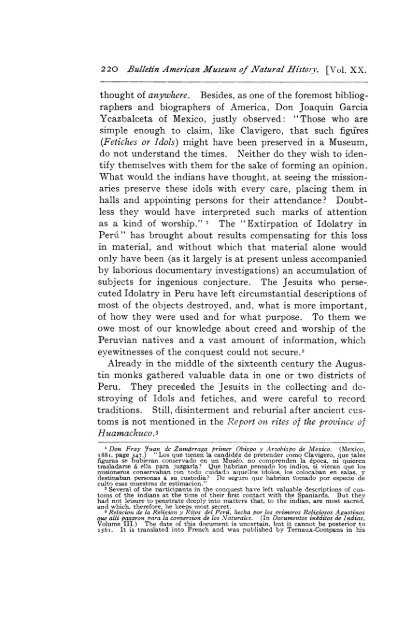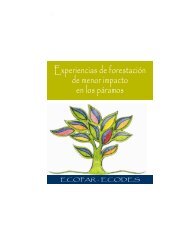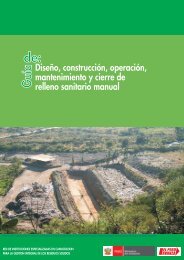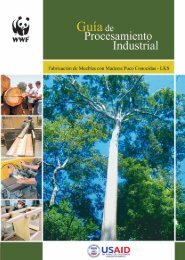You also want an ePaper? Increase the reach of your titles
YUMPU automatically turns print PDFs into web optimized ePapers that Google loves.
2 20 Bulletin American Museum of Natural Hist/or. [Vol. XX,<br />
thought of anywhere. Besides, as one of the foremost bibliographers<br />
and biographers of America, Don Joaquin Garcia<br />
Ycazbalceta of Mexico, justly observed: " Those who are<br />
simple enough to claim, like Clavigero, that such figu^res<br />
(Fetiches or Idols) might have been preserved in a Museum,<br />
do not understand the times. Neither do they wish to identify<br />
themselves with them for the sake of forming an opinion.<br />
What would the indians have thought, at seeing the missionaries<br />
preserve these idols with every care, placing them in<br />
halls and appointing persons for their attendance? Doubtless<br />
they would have interpreted such marks of attention<br />
as a kind of worship." I The "Extirpation of Idolatry in<br />
Perui" has brought about results compensating for this loss<br />
in material, and without which that material alone would<br />
only have been (as it largely is at present unless accompanied<br />
by laborious documentary investigations) an accumulation of<br />
subjects for ingenious conjecture. The Jesuits who persecuted<br />
Idolatry in Peru have left circumstantial descriptions of<br />
most of the objects destroyed, and, what is more important,<br />
of how they were used and for what purpose. To them we<br />
owe most of our knowledge about creed and worship of the<br />
Peruvian natives and a vast amount of information, whici<br />
evewitnesses of the conquest could not secure.2<br />
Already in the middle of the sixteenth century the Augustin<br />
monks gathered valuable data in one or two districts of<br />
Peru. They preceded the Jesuits in the collecting and dcstroying<br />
of Idols and fetiches, and were careful to record<br />
traditions. Still, disinterment and reburial after ancient customs<br />
is not mentioned in the Report on rites of the provinice of<br />
Huamachuco.3<br />
Don Fray Yuan de Zumndrraga primer Obispo y Arzobispo de Mexico. (MIexico,<br />
T88s, pa-ge 347.) "Los qtte tienen la candidez de pretender como Clavigero, que tales<br />
figuras se hubieran conservado en un Museo. no comprenden la epoca, ni quieren<br />
trasladarse a ella para juzgarla? Que habrian pensado los indios, si vieran que los<br />
misioneros conservaban con todo cuidaIDj aque'los idolos, los colocaban en salas, v<br />
destinaban personas a su custodia? De seguro clue habrian tomado por especie de<br />
culto esas muestras de estimacion."<br />
2 Several of the palrticipants in the conquest have left valuable descriptions of customs<br />
of the indians at the time of their first contact with the Spaniards. But they<br />
had not leisure to penetrate deeply into matters that, to the indian, are most sacred,<br />
and which, therefore, lhe keeps most secret.<br />
3 Relacion de la Religion y Ritos del Persi, hecha por los orimeros Religiosos Agustinos<br />
que alli pasaron P'ara la conversion de los Naturales. (In Documen1tos ingditos de Indias,<br />
Volume III.) The date of this document is uncertain, but it cannot be posterior to<br />
1561. It is translated into French and was published bv Ternaux-Compans in his








